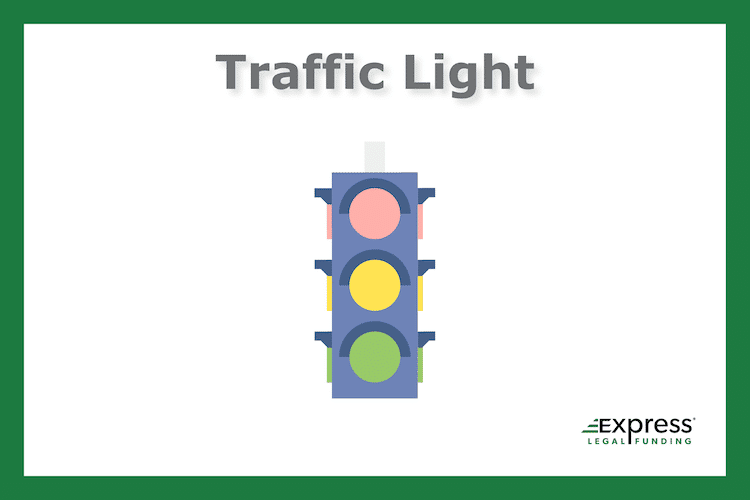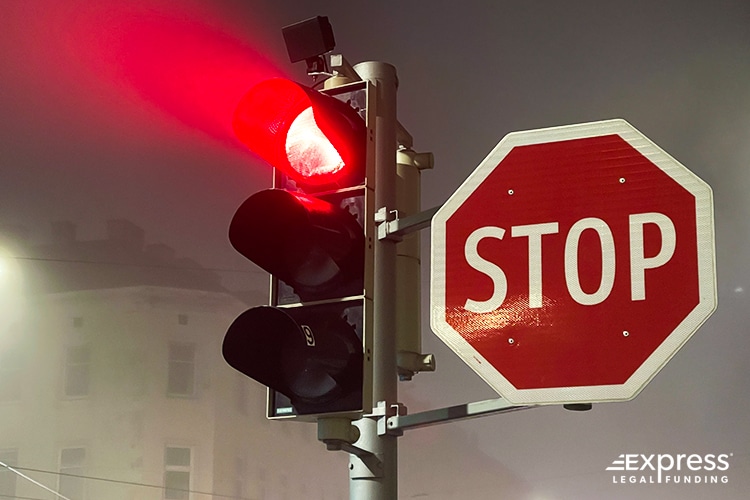
Even for the most experienced drivers, it can be easy to be thrown off and surprised by the rules of the road depending on the circumstance, especially since they are not the same across the nation.
Knowing what to do and under what circumstances can feel nerve-racking at times. It can go from simple to complicated in the blink of an eye.
Although we all initially have to go through a driver’s education course and pass the test at the DMV to ensure we are equipped to drive safely and handle the rules of the road.
So that should mean we will have all learned about traffic signals, flashing red lights, cross-traffic, stop signs, speed laws, and more to help us follow driving laws.
This education is the first step to making us safer while driving and avoiding car accidents, and in the process, it helps us maintain our legal rights when getting pulled over by law enforcement.
This knowledge about traffic laws is all the more crucial as motor vehicles are one of the most important yet, simultaneously, one of the most hazardous items the average person can own.
Tens of millions of motorists rely on their private cars and trucks to work every day the large.
Hence, the need for drivers to follow the rules of the road and drive safely is all the more reason preventing auto accidents should be a priority, as the road can quickly become a dangerous and fatal place to be.
With that said, the expectation for whether these are successful is if they reduce the number of accidents and crashes instead of stopping them altogether.
So when a tragic car or motorcycle accident occurs, there is legal recourse that can be taken in a court of law to compensate the victim via a personal injury or wrongful death claim claim.
However, the legal issues around proving the case can be very complex and rarely straightforward, especially as the circumstances of many car accident collisions can involve some rarer traffic laws that can come into play.
Flashing Red Traffic Lights At Intersections
One rare and lesser-known circumstance we can encounter while driving is a flashing red traffic light, which due to its confusing nature, can help us realize how much we depend on our traffic light system to function fully.
When we pull up to a four-way intersection and are met with flashing red lights, it can be confusing, and these confusing traffic signals lead to red light crashes.
Although not the most regular occurrence or common cause for accidents, flashing red traffic lights do happen and are bound to come up sooner than later.
So knowing what flashing red lights mean and what to do is something you should consider if you want to take an easy step to remain safe while driving.
Similarly, determining fault in unusual circumstances can be daunting, especially for those without experience with such issues.

Unfortunately, when you are involved in a collision at a flashing red light, things become even more confusing than they would normally for the average auto accident if you do not know the rules.
Intersection Car Accidents
Fortunately, this easy-to-read guide teaches you how the opposite is often the case for intersection accidents.
The reason is accidents with a broken traffic signal, and flashing red lights situations are more straightforward and easier to prove when it comes to their impact to help identify who you can hold responsible in a car accident injury lawsuit.
We will begin with going through the basics and then move on from there to our FAQs guide about flashing red lights and their associated intersection traffic law rules.
So let’s get started!
What Does a Flashing Red Light Mean?
What a flashing red light means is actually more simple than it seems.
The flashing red lights instruct you that you are required to stop at the intersection like you would a stop sign by bringing your vehicle to a complete stop and then following the right of way laws before looking to your left and your right to safely proceed across the intersection.
Flashing red lights work the same way as a four-way stop sign, where the drivers take turns by yielding to the driver on the right.
Further, pedestrians take priority on crosswalks, and any vehicle that arrives at the light intersection and comes to a full stop prior to you gets to cross or make their turn before you.
If the vehicles arrive after you, they must yield to you, allowing you to make your driving move.
Traffic lights are among the most essential and common markers we encounter while driving and serve to inform us when to stop or continue driving outside neighborhoods on city streets.
Anyone who has seen a traffic light knows that it does this with color-coded lights that turn from a red light to a green light and finally to a yellow light that warns us to slow down because a red light is coming.
These basic traffic lights rules are simple enough that even many children who cannot legally drive for years can recognize and even explain the basic concept of how traffic signals work.
However, for clarity’s sake, we will define what green, yellow, and red lights mean, including what your options are while stopped at a red light.
The Three Traffic Lights Phases At an Intersection
- A green light means permission to proceed (you can go).
- A yellow signals caution to drivers to slow down and prepare to stop.
- A red light means stop and wait to go until it turns green. You make a right turn on a red signal after making a complete stop in the right lane and yielding.
Traffic Signal Phase Diagram [Video]
Still, even with this relative simplicity and long history, traffic lights have evolved into adopting modern technologies and, as a result, are prone to the same failings that afflict all modern equipment connected to the power grid.
What Makes Flashing Red Traffic Lights Start Flashing?
Traffic lights are connected to a central power source (power grid) that keeps them and our cities operational. So, in short, when a traffic signal loses power and then turns back on, that is when the flashing red traffic lights start to flash.
Although there are exceptions to this.
Although there are exceptions to this, for instance, some cities purposely switch traffic lights into a red flashing light mode late at night when there are few drivers on the road to make, as it allows drivers to get to their destination more quickly only to stop for the “red light stop signs.”
Why Do Traffic Signals Lose Power?
There are two common causes for traffic lights to lose power, but ultimately they both come down to losing connection to a power source.
- Larger-scale power outages in a city or town that is the result of inclement weather, such as thunderstorms, tornadoes, or hurricanes.
- Auto accidents and crashes where there a collision is made into the traffic light pole at an intersection or location connecting the power to the traffic signal.
This is the story for most traffic lights, except for those in places that equip them with backup batteries.
So if the electricity goes out, they will lose power and not function at all until their primary power source is restored, which means being reconnected to the working central power grid.
The moment the traffic lights are reconnected and regain functionality, that is when the red flashing lights start.

Red Flashing Traffic Lights Are the Same As a Four Way Stop
This flashing red light mode transforms the traffic light into the equivalent of a standard four-way stop sign.
The concept is relatively simple and reinforces a driver’s behavior at ‘Stop’ signs while not jeopardizing the familiarity of traffic lights.
While some might initially panic at the sight of a flashing light, most drivers can adapt to the situation without issue.
That said, there are exceptions where drivers end up in car crashes due to one or more parties failing to yield to oncoming traffic appropriately.
Accidents of this nature can be dangerous and confusing to navigate, but proving who is at fault can be relatively easy, especially compared to many car accident case types.
Who Is At Fault In a Red Light Accident?
Determining fault over a motor vehicle or motorcycle accident is essential to seeing financial justice served.
It helps to ensure the driver responsible (or their car insurance company) for the accident is held to pay for the injuries and damages of the victims of the intersection accident.
While proving who is at fault is essential to car accident injury lawsuits, it is not as simple as pointing at the person you know who hit you and saying they are the at-fault party.
The party responsible for the flashing red light accident will be the one who fails to adhere to right-of-way regulations.
Example #1: Intersection Accident With Red Flashing Traffic Lights Where You Are Accident Victim
For example, let us say you and three other drivers arrive at an intersection with a traffic light that is flashing red in the following order:
- Car A
- Car B
- Your Car
- Car C
Because Car A arrived at the intersection and came to a complete stop first, they have the right-of-way. Let us say Car A and Car B both make their left turns, meaning the next turn is yours.
You begin driving into the intersection, only for Car C to drive directly into you with a right turn, resulting in an accident.
Since you had the right-of-way, Car C is at fault for the accident since they violated the traffic laws.
Example #2: Flashing Red Light Traffic Accidents Where You are the At-Fault Driver
Alternatively, you did the same thing to Car B in the middle of their turn. That would put you at fault since you disregarded Car B’s right-of-way.
Example #3: Rear-End Collision At Intersection While Waiting On a Red Light
Finally, let us say that while waiting for your turn at the stop line, another car began driving up behind you. If they fail to stop and rear-end you, they are at fault for failing to recognize the significance of the flashing red light.
In general, rear-end collisions are always the fault of the driver that hits the back of your car.

While this might seem clear-cut, recognizing who is at fault and proving it are two different things.
Even if you are not at fault for the accident, the burden of proof lies with you and your legal team.
Fortunately, proving fault is more straightforward than it might seem, though there is a lot of work to do if you want to succeed.
How To Prove Fault In a Flashing Traffic Light Accident?
For a case to be made against a negligent driver, the evidence must prove the accused driver is at fault for the accident. Typically, this process is complicated because accidents can occur almost anywhere on the road and might not be visible to pedestrians or surveillance cameras.
However, car accidents at a flashing traffic light stand out with one advantage that most other accidents lack:
Red Light Runner Traffic Camera Recording As Evidence:
Virtually every traffic light in cities and metropolitan areas is equipped with cameras designed to capture photographs of vehicles that run red lights.
This might seem like a moot point if the camera is connected to a traffic light that lost power. Since the red light is not functioning as intended, the camera might not work until a technician repairs the entire thing.
Fortunately, there are circumstances where a critical error does not inhibit the camera’s functionality at the traffic light.
Some red light ticket cameras only activate and take photos through sensors in the ground. However, most modern CCTV traffic cameras actively record the intersections they are monitoring.
So whether a camera can capture images regardless of the traffic light’s status depends on the type of camera installed.
The cameras that record video footage and not merely take photos when they detect a driver running a red light have a higher chance of documenting an accident at the intersection and providing evidence of who caused the incident.
The recordings at traffic intersections are not saved forever, so a request must be made for the footage.
But this evidence is almost irrefutable except for rare circumstances where the range is not wide enough to capture the entire area—your chances of proving fault increase drastically if the flashing traffic light is equipped with a modern camera.

Bear in mind that the camera still needs to be restored and have time for its software to recalibrate. That means the chances of the traffic camera being viable when a traffic light is in flashing red light mode is less likely.
While you might not be able to rely on traffic camera footage to prove the other driver’s fault in the accident, you still have access to alternatives.
There are some methods for proving someone else’s fault that do not require traffic camera recordings, such as filing a police report or witness accounts from nearby motorists.
The primary approach is to photograph the damage to both vehicles after the accident to show how it aligns.
A vehicle that hits the side of your car will have corresponding damage on its bumper.
Unfortunately, these situations are complicated by the fact there is little evidence to prove they were the ones who violated the right-of-way laws instead of you.
Sometimes the angle of the damage can corroborate your side of the story, but you will likely need additional evidence to cement your claim.
Fortunately, the odds of you and the other driver being alone at the intersection are slim.
There will almost certainly be other drivers at the intersection with you unless you are driving in the middle of the night when there is little traffic.
Witness Testimony About Accident Is Evidence To Prove Fault
These other drivers and pedestrians can serve as witnesses to the event and describe what they saw to the responding officers.
The more witnesses, the easier it will be to prove what happened and show that the other driver is at fault; this is one of the examples of proof that persists regardless of the traffic light’s status.
Witness statements and photographic evidence can compensate for traffic cameras that lost functionality during the accident.
All this information contributes to what comes after the accident, too.
Should You Hire a Car Accident Lawyer?
Regardless of the traffic light’s status, you are entitled to compensation when you are the victim of a motor vehicle accident. So, yes, contacting a car accident attorney for a free consultation and evaluating your case is something you should consider at the very least.
They can help you prove fault, which is a part of filing a lawsuit against the negligent driver, and by doing so, your medical bills and the property damages you suffered can be determined not to be your financial responsibility.
These lawsuits are among the most common in the civil courts and are likely to affect most of the population at some point.
Negligent and distracted driving accidents can be caused by a myriad of factors, such as DUI or driving while wearing headphones.
Filing a personal injury claim is pretty simple and requires you to lodge an official complaint with the defendant’s insurance companies.

Usually, a car accident attorney or law firm is used to negotiate on your behalf and demand a suitable settlement to pay your losses.
Damage to your vehicle is one of the main points of negotiation that your car accident lawyer will use, but it will also factor in medical bills and emotional damages.
Depending on the severity of your injuries, you stand to earn a significant settlement you can use to pay your expenses.
You must file your claim for personal injury within your state’s statute of limitations.
On average, that will give you two years from the date of the accident to explore legal options and file a lawsuit.
Unfortunately, filing a personal injury claim comes with some disadvantages you must consider.
If the evidence confirms the defendant is at fault for violating the right-of-way at a flashing red traffic light, the claim will end in your favor. While there is no guarantee that the claim ends precisely how you want it, it will be an essential tool for recovery.
Closing Statements On Flashing Red Traffic Lights and Car Accident Lawsuits
Flashing red lights at a standard traffic light might be disconcerting if you are a new driver or even if you are experienced.
When an accident occurs at these flashing traffic lights, it can seem more confusing than it is and leave you scrambling.
These situations challenge drivers’ expectations and cause them to make otherwise avoidable mistakes. Unfortunately, these mistakes tend to have others paying the price for their negligence.
Fortunately, all you have to do is file a claim and show the evidence proving that another individual was the at-fault driver that caused the collision.
The downside is that filing claims of this nature takes time, which can make you want to settle too early for too little when you are low on cash.
Taking a settlement for less than you deserve is a cost you want to avoid.
However, filing a personal injury claim will not have you paying any legal fees to a car accident law office until after your case is successful, you still have to pay for the cost of living.
These expenses can quickly overwhelm you, especially if you are already struggling financially.
The good news is that this does not always need to be the case, especially when it comes to our team at Express Legal Funding being able to help you.

We at Express Legal Funding are a pre-settlement funding company based in Plano, Texas, and we help clients across the nation. Specifically, we can help you pay your way for your personal expenses while your attorney fights for your claim.
Apply For Pre-settlement Funding For Your Car Accident Injury Case
Our legal funding service is a risk-free financial product. How it works is that non-recourse lawsuit funds can be advanced to you so you can use them as you see fit to pay for essential services like housing or power. It’s not a loan.
Instead, it’s non-recourse pre-settlement funding, which is a purchase agreement between a seller (legal funding client) and a buyer (consumer legal funding company).
That means through the pre-settlement cash advance we can give you, we are buying the right to our repayment, which is contingent upon the existence of there being case proceeds.
So we only get paid back from the settlement or trial claim money, and not from you, the plaintiff’s pocket, directly.
That is where the non-recourse if you lose your case, you owe us nothing part of the pre-settlement funding agreement, comes into play.
(Important info for Missouri consumers: Please note that the type of financing we are licensed to provide to injured and damaged claimants in Missouri are recourse loans and, therefore, not risk-free advances contingent upon settlement or trial proceeds.
Pre-settlement loans and post-settlement funding in states like Missouri are recourse loans and must, technically, by law, be repaid. Express Legal Funding-Missouri, LLC is a loan company licensed to give these loans in MO.)
If you need financial assistance and have an ongoing car accident injury claim, we encourage you to visit our website to learn more about legal funding.
Plus, you can give us a call anytime to get the fast application process started. We are here to help!
